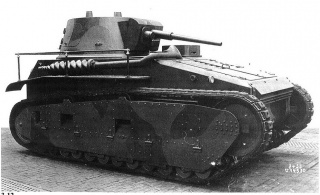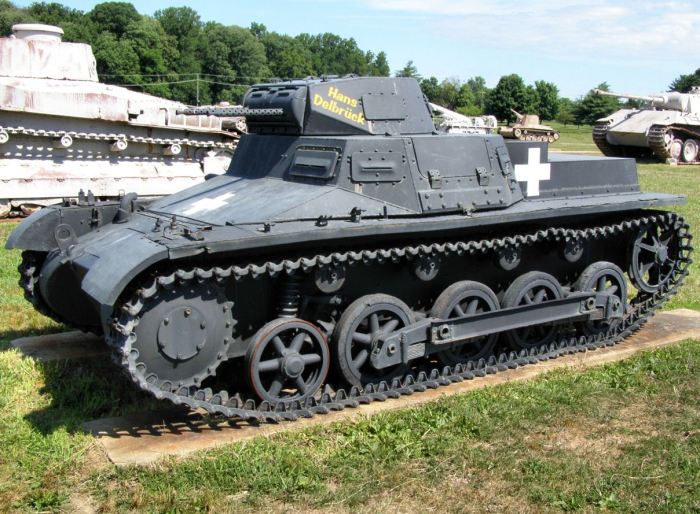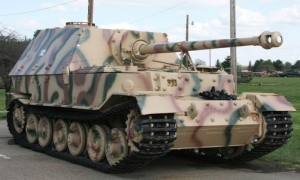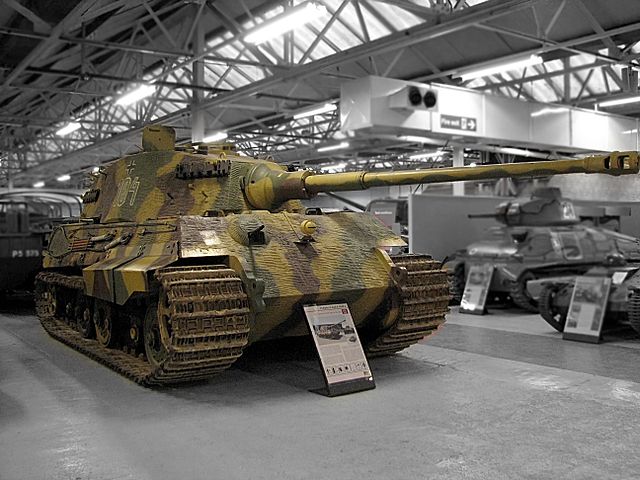(Be sure to read the extensive footnotes after this issue.)
So I may have lied to you two weeks ago about discussing World War I. I’m going to perpetuate that lie and talk about Panzers, because Panzers are cool. Deviating from the proposed plan shouldn’t hurt my ratings anyway. I don’t have ratings.
The Panzer was almost groundbreaking, as far as tanks were concerned. While in World War I the British showed the world that the tank was to become part of the future of warfare, in World War II the Germans showed the world that the tank was to become part of its backbone. The Nazis built 25,767 tanks during World War II (excluding prototypes like the Maus and vehicles never intended for combat like the Leichttraktor*). The Soviet Union had 22,000 tanks by the end of the war. While this makes it appear that Germany outnumbered even the Soviet Union, consider that the Soviet Union had in excess of 18,000 tanks at the start of the war, and Germany’s not quite 26,000 was their entire production history.
I claim that the Panzer was groundbreaking, but the original Nazi plan for the tank was not the formidable Tiger seen toward the end of the war. This was the Leichttraktor tank, which was only ever designed for training, but nonetheless an example of the first Panzer:

Yes. Since I am adverse to confusing you and adding non-Panzer images, quickly google the British Mk. V tank, produced twenty years earlier. It would eat this light tank for breakfast. This tank was only produced as an experiment — a template for future Nazi tanks to follow. The Soviet Union and Germany shared a top-secret testing ground within Russia where both powers tested new tank models and trained together; this was the only interaction the Leichttraktor had with a foreign power.
The Panzerkampfwagen (Armored fighting vehicle) I was just as bad a tank as the Leichttraktor, if not worse. This is almost excusable as the tank was only developed to train the new Panzer force and familiarize the Wehrmacht with their new backbone. It stopped being excusable thanks to Franco. The Spanish Civil War saw Franco’s Nationalists against the “Popular front” communists. The Soviet Union and Nazi Germany used this opportunity to wage a proxy war and test their experimental weaponry without ever firing a shot for themselves. German tanks were defeated by Soviet armored cars, and the Nationalists turned to capturing Soviet tanks to even the fight. While the use of Panzers during the Spanish Civil War shaped the German Blitzkrieg on Poland and France, it also told the Russians just how useless the first Panzers were.
Oh, and while you’re reading, here’s what the thing looked like:

Yes, those are machine guns. You see why it failed.
Even despite those failings, due to tank shortages, these vehicles continued to see use during the first half of the war, participating in all German invasions (excluding the Soviet Union**) and Africa. Superior strategy and tactics allowed these tanks to succeed even as the Panzer IV was in production. These tanks were finally put down before D-Day and their turrets repurposed for bunkers along the Atlantic Wall. The Pz. I remained in Spanish service until replaced by the M47 Patton in 1954.
The Pz. II was largely the same affair and served as a scouting tank. It was not designed very seriously and only meant to serve as a rushed and immediately ready tank while Krupp and Porsche designed heavier models. Starting from the Battle of France, it was the most common tank the Germans had. Its turrets had the same fate as the Pz. I’s by the end of the war.

Aww. It’s so cute. And pathetic.
The Nazis were saved by the invasion of Poland by the Pz. III and IV:


These tanks were the first diverse ones: the Pz. III’s chassis also saw service in the Sturmgeschütz III, Flammpanzer III Ausf. M, Minenräumer III, and Panzerbefehlswagen III**. The Pz. IV chassis was also used in the Jagdpanzer IV tank destroyer, StuG IV, and… Wirlbelwind self-propelled anti-aircraft gun, which is so silly-looking I’ll show it to you.
Wirbelwind. I’m not going to get over that.
Anyway, these tanks were also the first tanks to make use of the “Ausf.” abbreviation — Ausfürung, the German equivalent to the “mark” designation — and they made extensive use of it. The Pz. III saw models between Ausf. A-N, and the Pz. IV had variants ranging from Ausf. A to J, including in-between modifications with designations like “F2.” I have chosen to depict a Pz. III Ausf. H and Pz. IV Ausf. F2, as they are some of my aesthetically favorite tanks of all time (I prefer the IV Ausf. H, but it features armor skirts and spaced turret armor that most Panzers did not have and I wanted a representation more accurate of all Panzers of the period). If you think of a Panzer, you will either envision a Tiger or a Panzer IV.
The Panzer III was the first main battle tank of the Nazis. It was outclassed by comparable Soviet models, but fortune smiled on Germany and the majority of tanks the Pz. III faced were semi-obsolete models; combined with superior German tactics the tank was a success on the Eastern Front. Its role was replaced by the Pz. IV and Panther tanks after the miserable Battle of Kursk (let’s put it this way… you walk in with three tanks and they walk in with seven. You take out three of theirs. They take out one of yours and decide to send in three more tanks. Who is losing? Curse the T-34.).
The Pz. IV was a good tank, all things considered. It butchered enemy armor in Poland, Denmark, France, and later the Normandy beaches, and its regular upgrades meant that it never fell behind the German standard. The KV-1 and T-34 were just better tanks. Their armor remained 100% impenetrable to the German forces when they were first encountered, and the KV-1’s only vulnerability was a single type of flak gun that still would ricochet from its sloped armor. German engineers did what any sane person would do and gave the Pz. IV a new gun and designation: Pz. IV Ausf. F2. (Hey, the one pictured above!) The nigh-ubiquitous T-34 was no longer a problem, though the rare and expensive KV remained a monster throughout the war. (So there, Hovawart. They’re not all that better.)
The Panther! This is what some people, myself included, think or thought “Panzer” meant. “Panzer” actually means “armor.” “Panther” in German is… “Panther.”

The PzKpfw V Panther† was specifically designed with Soviet armor in mind and was intended to fully replace the Pz. III and IV. With incredible armor and firepower, it almost succeeded, and as mentioned above it did become the main tank of the German forces, rightly earning notoriety alongside the Tiger. It actually had a better gun and frontal armor than the Tiger I, essentially the same engine as the Tiger I (that will become important in a minute), cost less than half the Tiger I and barely more than the Pz. IV. However… in their attempt to simplify the inner workings of the tank for higher production rates, the Germans created numerous technical problems that remained unresolved when the Panther was rushed to the Eastern Front. They suffered quite a few losses from mechanical failure alone. While the blueprints were adjusted by the end of the war, Allied advancement caused fuel shortages, loss of testing ground, and most importantly a lack of metal resources or factories to build Panthers. It spawned two notable variants: the Ausf. F (there were no Panther Ausf. A-E) and the Jagdpanther (hunting panther) was built upon its chassis. Due to the above flaws and shortages, it was not nearly as feared as weaker models despite its firepower and armor.
So, how’s about the fearsome Tiger? Everyone knows what a Tiger tank is; it is perhaps the most iconic tank of the war, above even the Sherman. It is renowned for its terror. However, the Tiger I was not the first Tiger. First came the Tiger (P), officially known as the VK 4501 (P). In 1942, Porsche and rival company Henschel & Son were asked to submit designs for a new, bigger tank chassis, which was to be outfitted with a Krupp turret.

Ferdinand Porsche (left, in civilian dress) with the Porsche Tiger.
Porsche’s tank was a technical mess. Its complex engineering created too much room for failure, and due to a copper deficiency in Germany at the time, its electrical systems were wired with a low-quality copper that caused extensive breakdowns. It was not very maneuverable and literally required almost constant maintenance, including while running. If this entirely-accurate image doesn’t sum things up, I don’t know what does:

The German government used Henschel’s design and the pre-built Porsche chassis went into the Elefant tank destroyer (also known as the Ferdinand).

It was very good at blowing away Soviet tanks from a range of three kilometers, but suffered from a total lack of peripheral vision and not a single antipersonnel gun. Soviet infantry learned to wait until the tank had crossed their lines and then destroy it from the sides or behind with grenades and Molotov cocktails. This is why you have that little slit in the front of the tank, remember, guys? To see? Put some in the sides.
The Tiger I was the PzKpfw VI Ausf. H† (for Henschel — H was the first model), but later redesignated Ausf. E. Again, this was the first model and there were no Ausf. A-D. The Nazis just liked confusing their operators. It was an effective tank in the West, but the snow, ice and mud would freeze between the wheels and immobilize the tank; the transmission could not handle too much strain; it was difficult to transport by truck (good luck finding a railway line out there); and it was a gas-guzzler. It was not suited for the harsh Soviet winter and off-road combat.

Tiger I inevitably implies that there is a Tiger II (or that the Germans suck at designations, cf. Porsche Tiger, Tiger I & Leichttraktor). The Tiger II was, obviously, and upgrade from the Tiger I, and it is telling that when I google “Tiger II v,” Google suggests “Tiger II vs. Abrams” as the third option after the Tiger’s contemporaries. Whether it’s telling that the Tiger II is that advanced, the Abrams is that terrible, or people are that stupid as to not know which would win in a battle, I don’t want to find out.

The rough, wavy coating on this tank is “Zimmerit” — it prevents anti-tank mines from magnetically attaching to the armor. Ironically, only Germany used many magnetic mines.
This was not actually a different Tiger. The “Tiger II” was the Panzerkampfwagen Tiger Ausf. B. I’m going to emphasize this point: The Tiger H came first and it was renamed the Tiger E. It was upgraded and named the Tiger B. Evidently the German alphabet starts with Z and ends with A. The German alphabet is also missing about 75% of English letters. It was known as the Königstiger — this name was not official and refers to the Bengal tiger. While “König” is “king,” the word “Königstiger” does not mean “king tiger,” as Allied forces often thought. The “King Tiger” tank is a mistranslation, if an understandable one.
But here I go about semantics. Let’s talk about TANKS. The Tiger II did not suffer the technical flaws of its contemporaries (it was designed somewhat alongside the Tiger I), but it still wasted a lot of fuel and and considered underpowered for a heavy tank. More orders were made for the Tiger II than the Tiger I, but the destruction of factories meant that only 492 units were made during the war. In a series of bombing raids over a two-week period, 657 Tiger IIs were destroyed in production.
The Tiger II chassis was used for the heavy tank destroyer Panzerjäger Tiger Ausf. B, known more simply as the Jagdtiger. It’s very ugly and reminds me of the Soviet SU-152, so I’m not going to show it here. If you have to see it, google it.
There are some other tanks here I didn’t get to talk about (not to mention tank destroyers and assault guns), so I expect another issue will be released describing those. I particularly wanted to cover the Maus (the featured image at the top of this issue), but this issue has gotten so long that I’ll pass for now. Instead, have a Maus:

(Also reminding you now that I have four footnotes that expound upon some things above)
* The Leichttraktor’s name stems from the fact that Germany was not allowed to have tanks or aircraft after the Versailles Treaty. During the early development and testing of the vehicles, they were disguised as “tractors” — hence the name “light tractor.” How or if this fooled anybody I don’t know, and I almost hope never to know. You’d have to be an idiot to see this wasn’t a tank. Good thing they did their testing in the Soviet Union.
** The Germans realized that as even their newest Panzer models were outclassed by Soviet armor, the Pz. I would be a waste of manpower. These tanks did participate but were relegated to towing loads through terrain where ordinary vehicles would have trouble.
*** You can tell I’m having fun with these. The tanks above were, respectively: a tank destroyer/assault gun, flamethrower tank, minesweeper, and command tank with a long-range radio and… no functioning gun.
† Hitler personally ordered the “V” removed from the Panther’s designation for unknown reasons; the same went for the Tiger. They are officially just the PzKpfw Panther and PsKpfw Tiger Ausf. E. The Pz. VII Löwe and VIII Maus both retained their numerals.

























